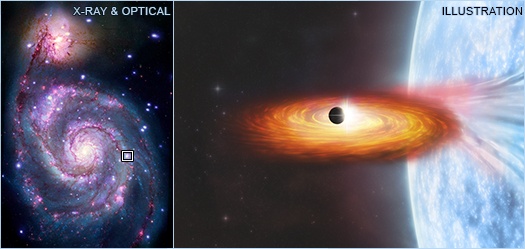Discovery of the first exoplanet candidate in X-ray binary M51-ULS-1 in the spiral galaxy Messier 51 (M51), also called the Whirlpool Galaxy using transit technique by observing dips in brightness at X-ray wavelengths (instead of optical wavelengths) is pathbreaking and a game changer because it overcomes the limitation of observation of dips in brightness at optical wavelengths and opens up the avenue for the search of exoplanets in external galaxies. Detection and characterisation of planets in external galaxies has significant implications for search for extra-terrestrial life.
“But where is everybody?” Fermi had blurted out, way back in the summer of 1950, pondering why there is no evidence of any extra-terrestrial life (ET) out in the space despite high probability of its existence. Three quarters of the century past that famous line, still there is no evidence of any life anywhere outside the Earth, but the search continues and one of the key components of this search is the detection of planets outside the solar system and its characterisation for possible signatures of life.
Over 4300 exoplanets have been discovered in the past few decades which may or may not have conditions suitable to support life. All of them were found within our home galaxy. No exoplanet was known to be discovered outside the Milky Way. In fact, there is no evidence to support the idea of presence of planetary system in any external galaxy.
Scientists have now reported discovery of a possible exoplanet candidate in an external galaxy for the first time. This extrasolar planet is in the spiral galaxy Messier 51 (M51), also called the Whirlpool Galaxy, situated at a distance of about 28 million light years away from home galaxy Milky Way.
Usually, a planet is detected by way of observing eclipse it produces when it transits in front of its star while orbiting around thus blocking the light emanating from the star (transit technique). This event is observed as temporary dimming of the star. Search for an exoplanet involves searching for dips in the light of a star. The other method of detection of planets is by radial velocity measurements. All exoplanets have been detected using these techniques in our home galaxy at relatively short intra-galactic distances in the range of 3000 light years.
However, searching for dips in the light at larger inter-galactic distances to detect exoplanets outside the Milky Way is an uphill task because an external galaxy occupies a small area in the sky and the high density of stars does not allow study of an individual star in sufficient details to enable detection of signatures of a planet. As a result, search at optical wavelength in an external galaxy was not feasible until now and no exoplanet outside our home galaxy could be discovered. The latest research is pathbreaking and a game changer because it seemingly overcomes this limitation by observing dips in brightness at X-ray wavelengths (instead of optical wavelengths), and opens up the avenue for the search of exoplanets in other galaxies.
X-ray binaries (XRBs) in the external galaxies are considered to be ideal for the search of exoplanets. These (i.e., XRBs) are a class of binary stars made up of a normal star and a collapsed star like white dwarf or a black hole. When the stars are close enough, material from the normal star is pulled off the normal star towards the dense star due to gravity. As a result, the accreting material near the dense star becomes superheated and glows in X-rays appearing as bright X-ray sources (XRSs).
With an idea to detect planets orbiting X-ray binaries (XRBs), the research team searched for dips in the brightness of X-ray received from the bright X-ray binaries (XRBs) in three external galaxies, M51, M101, and M104.
The team finally focussed on the X-ray binary M51-ULS-1 which is one of the brightest X-ray sources in M51 galaxy. The dip in brightness of X-ray received by Chandra telescope was observed. The data about dip in brightness was examined for various possibilities and was found to fit for transit by a planet, most likely of the size of Saturn.
This study is also novel for carrying out the search of exoplanets successfully for the first time at X-ray wavelength. On the broadest level, this landmark discovery of exoplanet outside our home galaxy expands the scope of search of exoplanets to other external galaxies, which has implications for the search of extra-terrestrial intelligent life.
***
Sources:
- Di Stefano, R., Berndtsson, J., Urquhart, R. et al. A possible planet candidate in an external galaxy detected through X-ray transit. Nature Astronomy (2021). DOI: https://doi.org/10.1038/s41550-021-01495-w. Available online also at https://chandra.harvard.edu/photo/2021/m51/m51_paper.pdf. Preprint version available on https://arxiv.org/pdf/2009.08987.pdf
- NASA. Chandra Sees Evidence for Possible Planet in Another Galaxy. Available online at https://chandra.harvard.edu/photo/2021/m51/
- NASA. Science –Objects – X-ray Binary Stars. Available online at https://imagine.gsfc.nasa.gov/science/objects/binary_stars2.html
- Schwieterman E., Kiang N., et al 2018. Exoplanet Biosignatures: A Review of Remotely Detectable Signs of Life. Astrobiology Vol. 18, No. 6. Published Online on 1 Jun 2018. DOI: https://doi.org/10.1089/ast.2017.1729






































